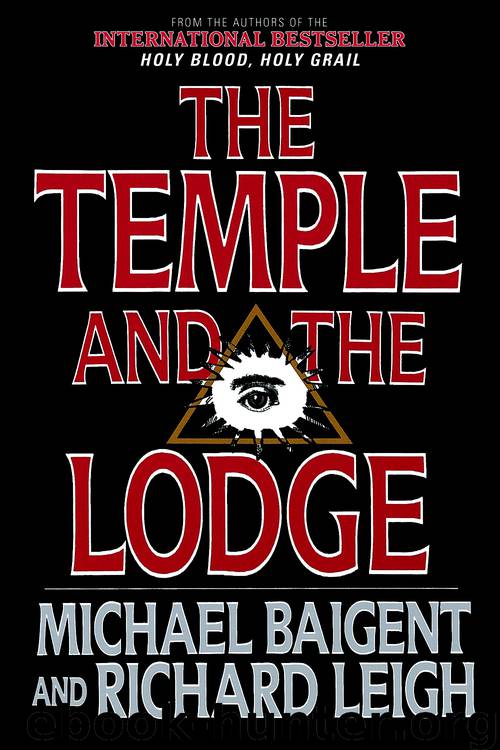The Temple and the Lodge by Michael Baigent

Author:Michael Baigent
Language: eng
Format: epub
Publisher: Skyhorse Publishing, Inc.
Published: 2011-03-31T16:00:00+00:00
Thirty-six years later, in 1682, Ashmole’s diary records another lodge meeting, this time in London, at the Masons’ Hall, and the list of those in attendance includes a number of prominent gentlemen in the City.16 Ashmole’s diary thus bears witness to a number of things — to his own continued allegiance to Freemasonry over thirty-six years, to the spread of Freemasonry across England, and to the calibre of the people associated with it by the 1680s.
Frances Yates notes it as a point of significance that, ‘the two persons of whom we have the earliest certain membership of masonic lodges were both foundation members of the Royal Society’.17 Together with Moray, Ashmole was indeed one of the Royal Society’s founders. All through the Civil War and Cromwell’s Protectorate, he was, like Moray, a fervent royalist, passionately dedicated to the restoration of the Stuart monarchy. And much more flagrantly than Moray, Ashmole displayed a preoccupation with chivalry and chivalric orders. In his history of the Garter, he addressed himself to the Templars — and became the first writer on record since the suppression of the Order to speak favourably of them. It is through Ashmole — noted antiquarian, expert on chivalric history, prominent Freemason, co-founder of the Royal Society — that one can discern what must have been a prevailing attitude towards the Templars in seventeenth-century Freemasonic and ‘Rosicrucian’ thought. Indeed, it is with Ashmole that the ‘rehabilitation’ of the Templars, at least so far as the general public is concerned, effectively begins. But Ashmole was not alone.
In 1533, the German magus, philosopher and alchemist Heinrich Cornelius Agrippa von Nettesheim first published his famous opus, Of Occult Philosophy. This work is one of the landmarks of ‘esoteric’ literature, and it consolidated Agrippa’s reputation as the supreme ‘magician’ of his age — the real prototype, more than any historical Georg or Johann Faustus, for the figure in Marlowe’s play and Goethe’s dramatic poem. In the original Latin edition of his work, Agrippa mentions the Templars in passing. His comments reflect what, in the absence of any contrary evidence or tradition in Germany at the time, was the prevailing view of ‘the destestable heresy of the Templars’.18
In 1651, the first English translation of Agrippa’s work was published. It contained a short dedicatory poem of praise by the alchemist and ‘natural philosopher’ Thomas Vaughan — a friend and disciple, as we shall see, of Moray — and was sold in a bookshop in the churchyard of St Paul’s. Agrippa’s reference to the Templars had, in the original Latin, consisted of a few words in a text of more than 500 pages. And yet the anonymous English translator was sufficiently offended or embarrassed by this reference to change it. The English edition therefore refers to the ‘detestable heresy’ not of the Templars, but ‘of Old Church-Men’.19 It is thus clear that by 1651, two years after the death of Charles I, the ‘rehabilitation’ of the Templars was already under way. There were certain interests in England,
Download
This site does not store any files on its server. We only index and link to content provided by other sites. Please contact the content providers to delete copyright contents if any and email us, we'll remove relevant links or contents immediately.
| Baha'i | Cults |
| Demonology & Satanism | Eckankar |
| Egyptian Book of the Dead | Freemasonry |
| Messianic Judaism | Mysticism |
| Scientology | Theism |
| Tribal & Ethnic | Unitarian Universalism |
The Four Agreements by Don Miguel Ruiz(6322)
Breaking Free by Rachel Jeffs(4013)
The Hatha Yoga Pradipika (Translated) by Svatmarama(3077)
120 Days of Sodom by Marquis de Sade(2943)
Member of the Family by Dianne Lake(2262)
The Tao of Physics by Fritjof Capra(2168)
The Psychedelic Gospels: The Secret History of Hallucinogens in Christianity by Jerry B. Brown(2073)
The Road to Jonestown by Jeff Guinn(1983)
Going Clear: Scientology, Hollywood, and the Prison of Belief by Lawrence Wright(1884)
Going Clear by Lawrence Wright(1873)
Uriel's Machine by Christopher Knight(1823)
The Grand Grimoire: The Red Dragon by Author Unknown(1711)
The Gnostic Gospel of St. Thomas by Tau Malachi(1680)
Key to the Sacred Pattern: The Untold Story of Rennes-le-Chateau by Henry Lincoln(1556)
The Malloreon: Book 02 - King of the Murgos by David Eddings(1518)
Waco by David Thibodeau & Leon Whiteson & Aviva Layton(1488)
The New World Order Book by Nick Redfern(1485)
The Secret of the Temple by John Michael Greer(1422)
The Initiatory Path in Fairy Tales by Bernard Roger(1396)
